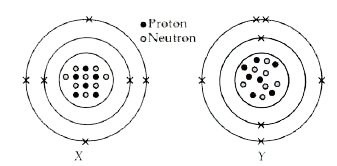In X - H----Y , both X and Y are electronegative elements
electron density on X will increase and on H will decrease
in both electron density will increase
in both electron density will decrease
on X electron density will decrease and on H increase
The correct Answer is:A
In X-H ---- Y, X and Y both are electronegative elements , then electron density on X will increase and on H will decrease.
Topper's Solved these Questions
Similar Questions
The given diagrams show the atomic structures of elements X and Y.

What are the electronic configurations of elements X and Y?
View SolutionIf x,y and z are electronegativity, ionisation potential and electron−affinity respectively. Then the electron affinity (z) in the terms of electronegativity (x) and ionisation potential (y) will be :
View Solution
Knowledge Check
Pauling's equation for determining the electronegativity of an element, is (XA,XB are electronegativity value of elements A and B respectively, Δ represents the polarity of A-B bond.)
AXA−XB=0.208√ΔBXA+XB=0.208√ΔCXA−XB=0.0208Δ2DXA−XB=√ΔThe correct relation given by Pauling to calculate electronegativity of an element X is (with respect to hydrogen). Given EN of X>EN of H
AEN(X)−EN(H)=0.208√BEH−X−√BEXX×BEH−HBEN(X)−EN(H)=0.102√BEH−X−√BEX−X×BEH−HCEN(X)−EN(H)=0.102√BEH−X−√BEX−X×BEH−H where bond energies (BE) are in kJ/mole.DBoth (a) and (c) are correctH-H, X-X and H−X bond energies are 104Kcal/mole60Kcal/mole and 101kcal/mole. Assuming the electronegativity of hydrogen to be 2.1 the electronegativity of unknown element X is (√19=4.36)
A3.5B3C4D2.5
The X-X bond length is 1.5 Å and Y-Y bond length is 1.48 Å.If electronegativity values of X and Y are 3 and 3.5 respectively,then Y-X bond length would be
View SolutionElement X is strongly electropositive and element Y is strongly electronegative. Both are univalent. The compound formed would be
View SolutionIf x,y and z are Mulliken electronegativity, ionisation potential and electron-affinity respectively. Then the electron affinity (z) in the terms of electronegativity (x) and ionisation potential (y) will be:
View SolutionThree elements, X, Y and Z belong to the same period. Their oxides are acidic, amphoteric and basic respectively. The order of electronegative of these elements in the periodic table is
View SolutionTwo elements X and Y contain only one electron in the outer level.Element X is reactive and loses electron easily while element Y is relatively unreactive and non-corrosive.The elements X and Y respectively are
View Solution
